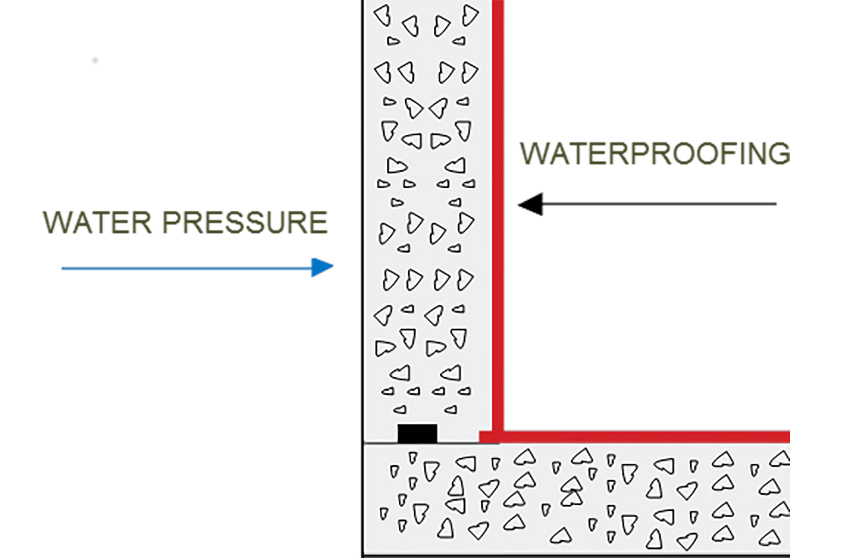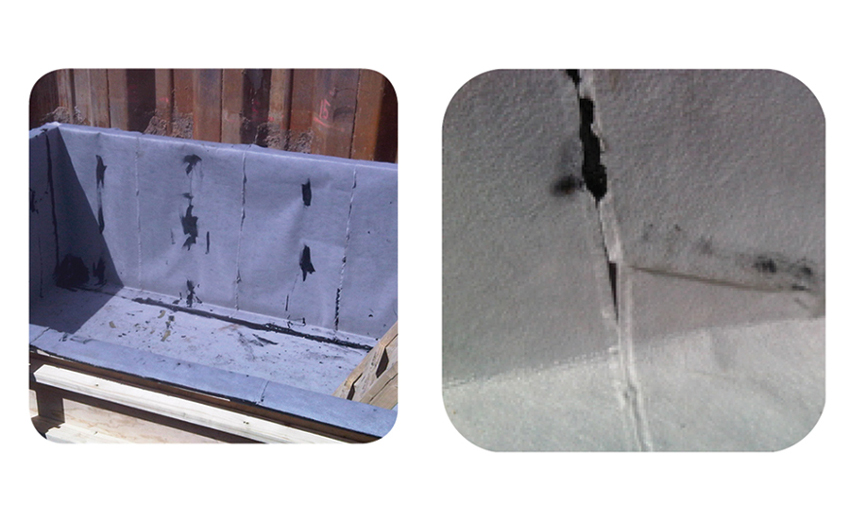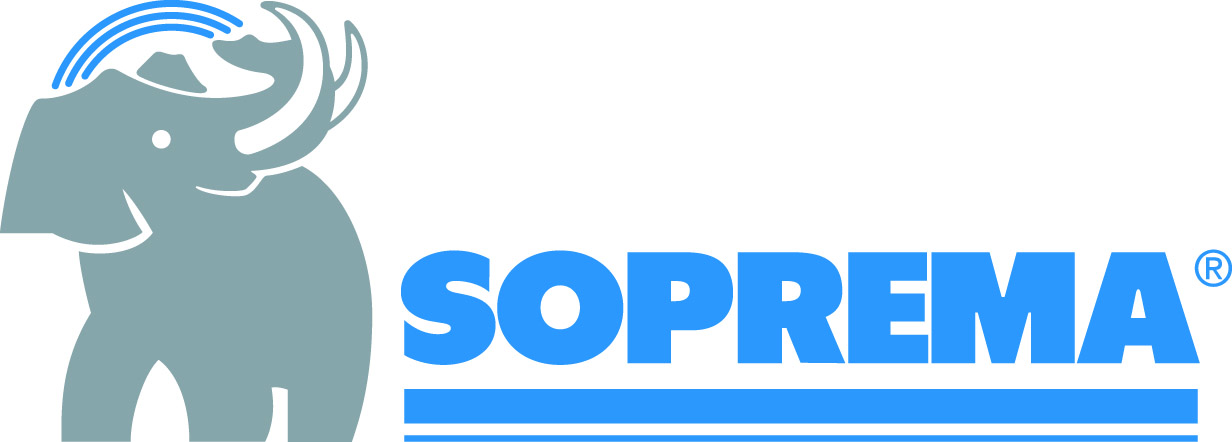
With negative-side waterproofing, membranes are installed on the interior side of the wall, preventing moisture from penetrating inside the space, but potentially allowing damage within the wall.
There is one additional form of below-grade waterproofing to know, as well: negative-side waterproofing. As you might guess from the name, negative-side waterproofing protects the surface opposite the side of applied hydrostatic pressure (e.g., the inside of a basement wall). Negative-side waterproofing keeps water from entering an occupied space and is applied to what is known as the dry face. Negative-side waterproofing is primarily used for water-holding purposes (preventing water from entering a space), but it does not prevent the water from entering the substrate (wall).
The main advantage of negative-side waterproofing is that it is accessible after installation for repairs or updates. Also, since the negative (interior) side of walls tends to be more accessible, it is easier to identify leak locations than with positive-side systems.
The fact that negative-side waterproofing allows moisture into the substrate is generally seen as a disadvantage, however. While moisture promotes active curing of the concrete substrate, it also contributes to the corrosion of the concrete and steel reinforcements from the groundwater and chemicals. The constant presence of moisture can also lead to mold growth or damage to interrelated building elements like floors or windows. This type of membrane does not protect against the effects of the freeze-thaw cycle and can only be used on cementitious systems. Additionally, if the building moves or cracks over time, additional negative-side waterproofing products may need to be added to close new gaps.
The materials used for negative-side waterproofing must be able to withstand hydrostatic pressure. Prefabricated membrane systems are typically installed in negative-side waterproofing applications via epoxy or urethane injections, cementitious coatings, metallic mineral application or crystalline application.
Since the goal of waterproofing is to protect both structures and the content within, but negative-side waterproofing does not necessarily protect the structure itself, negative-side waterproofing should generally be looked at as a temporary solution or problem-solving method that is mainly considered only if the positive-side waterproofing has failed or could not feasibly be installed in the first place.
Water Management & Protection
Keeping water out is one challenge; managing water and protecting newly installed below-grade waterproofing assemblies is another. This is why we also install protective layers, drainage layers and waterstops.
Protective layers, as their name implies, protect below-grade membranes from damage. This damage can either occur from backfill or consecutive trades. Depending on the membrane, common materials used in protective layers include insulation, asphaltic boards or an additional layer of HDPE. In some cases, layers serve dual purposes, such as insulation and drainage layers.
Drainage layers, alternatively, assist in the relief of hydrostatic head pressure and prolong the membrane life. Proper design means having the least possible amount of water reach the membrane, and water management is highly recommended in all below-grade assemblies. These panels are typically impact-resistant, dimpled plastic attached to a woven geotextile fabric, and they channel water away from the membrane.
Almost all below-grade waterproofing projects will have either a protection layer (board) to protect against possible damage from backfill operations or a drainage solution to manage the water away from the waterproofing membrane. Some drainage solutions can protect both the membrane and manage the water.
Waterstops provide a final level of protection for the building, existing within concrete sections, especially joints. These premanufactured joint seals are often comprised of PVC or chloroprene rubber that must be fused together, bentonite clay that expands when wet or hydrophobic injectable expanding grouts.
Causes of Waterproofing Failure
As is often the case with construction quality, the “devil is in the details” when it comes to effective below-grade waterproofing. It does not matter how great a waterproofing product is if it is not installed correctly—it can instantly perform worse than the worst waterproofing product in the world.
Improper Flashing & Detailing
Gaps in the integrity of the waterproofing due to incorrect detailing or damage from other trades are a leading cause for failure. The picture on the next page shows one example: rather than use the proper installation techniques, the contractors took it upon themselves to assure this elevator pit’s preapplied waterproofing was snug to the forms by using a staple gun to shoot staples through the modified bitumen membrane and into the wood forms. This created approximately 30 penetrations through the membrane that had to be detailed properly after the staples were removed (which you can see on the right). The correct repair procedure in this case was a patch over all the holes once the staples were removed … which added up to out-of-scope costs in excess of $10,000 once labor and materials were factored in.

Improper installation techniques can add up to costly fixes that are not within the original scope of projects.









